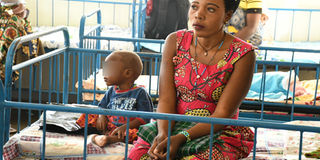Prime
Tooro battles malnutrition crisis

A woman with her baby, who was admitted to the nutrition ward at Fort Portal Regional Referral Hospital last Wednesday. Photo/ALEX ASHABA
What you need to know:
Mr Benard Bwambale, a nutritionalist, says majority of affected children suffer because their diet is limited to a single type of food, leading to nutritional deficiencies.
In the last five years, Tooro Sub-region, known for its food abundance and favourable agricultural conditions, has continued to struggle with high rates of malnutrition among children below the age of five.
Despite the region’s rich volcanic soils and ample food production, an alarming 42 percent of children remain malnourished, prompting experts to search for solutions.
Mr Benard Bwambale, a nutritionist at Research Centre Uganda, points out that the problem lies in lack of food rich in essential nutrients.
“As a region, we need to have a diversity of food, not only one type. We don’t need to keep saying that Tooro is a food basket because we don’t have a diversity of foods, people are only eating what they have at home, our foods are not safe because some people dry their produce on bare ground,” he says.
Experts said one contributing factor to the lack of food diversity is the tendency to export a significant portion of the region’s produce to other areas.
Mr Aggrey Gweita, the head of the Nutrition Department at Fort Portal Regional Referral Hospital, said: “Every day trucks come here to ferry matooke and other foodstuffs, and at the end, people remain hungry with no food for their families” .
According to data from the Uganda Demographic and Health Survey, Tooro Sub-region’s poor feeding practices have led to alarming statistics: 40.6 percent of children below five years are stunted, 2.4 percent suffer from wasting, and 10.3 percent are born with low birth weight below 2.5kg.
Kamwenge and Kyegegwa districts, which are hosts of refugees, bear a disproportionately high burden of malnourished and stunted children.
The prevalence of stunting in the refugee settlement of Rwamwanja in Kamwenge District is at 48 percent, while in Kyaka II in the Kyegegwa, it is 41 percent. In comparison, the prevalence for the host communities is also distressingly high, at 36 percent and 34 percent, respectively.
Last year’s report on nutrition at Fort Portal Regional Referral Hospital, revealed alarming statistics on malnutrition among children aged 0 to 59 months in Tooro, standing at a distressing 86.3 percent for those admitted to outpatient and inpatient therapeutic care.
Additionally, the percentage of pregnant women in the region receiving folic acid during their first antenatal care (ANC) visit from July to December 2022 was reported at 74.9 percent.
The nutrition unit at Fort Portal Regional Referral Hospital, which was designed to admit 16 patients, is consistently overwhelmed, admitting an average of more than 70 children each month.
The understaffed department compounds the situation, making it difficult to provide adequate care.
“The facility is supposed to admit 16 patients but we end up admitting at times 25. For a child to become stable, it takes about two weeks. Our department is understaffed. We need more staff to attend to patients but we thank Unicef for [donating] some medicine,” Mr Gweita said.
Way forward
Dr Samalie Namukose, the assistant commissioner of Health Services in charge of Nutrition at the Ministry of Health, last Wednesday said malnutrition necessitates the involvement of all stakeholders to combat the crisis.
She said at the national level 25 percent of children below the age of five years are stunted while for Tooro region is at 42 percent.
Dr Namukose urged parents to take their children to health facilities for specialised care at the earliest sign of malnutrition.
She added that the Ministry of Health has taken steps to address the issue of malnutrition through the implementation of a food and nutrition policy and health guidelines, targeting mothers and children.
Additionally, training packages have been developed to enhance the capacity of healthcare providers in handling nutrition-related cases.
She, however, highlighted limited funding as the main challenge in combating malnutrition.
“The money we are getting as the ministry is not enough to implement our planned activities to prevent malnutrition. We want to engage lawmakers to see that they allocate us enough money. We are supposed to carry outreach programmes but we don’t do them because of inadequate funding, the cost of malnutrition is not easy,” she said .
Government plan
The Ministry of Health has formulated a five-year Maternal, Infant, and Young Child and Adolescent Nutrition (MIYCAN) Action Plan from 2020 to 2025. The plan targets different age groups, including children aged 0 to 5 months, 6 to 23 months, and 24 to 59 months, as well as women of childbearing age (15 to 49 years) and adolescents aged 10 to 19 years.
The ambitious MIYCAN Action Plan aims to achieve several goals by 2025, including increasing the coverage of nutrition-specific services to at least 80 percent of infants, young children, and pregnant and lactating women.
Additionally, it seeks to provide access to nutrition-specific services to at least 60 percent of adolescents. To achieve these targets, collaboration with relevant sectors and line ministries that support nutrition-sensitive interventions is essential.
However, the successful implementation of the MIYCAN Action Plan hinges on securing adequate funding. The plan estimates a total cost of $513.9 million over five years, with an immediate requirement of $107.5 million for the first year and an average of $103.1 million per year for the subsequent three years.




